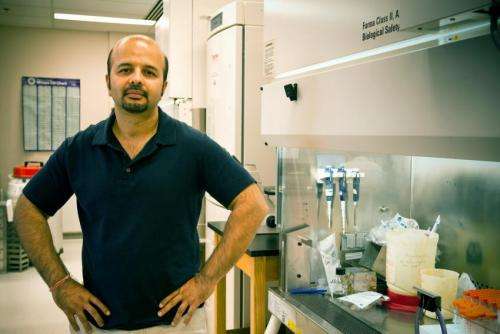Researchers identify key mechanism and potential target to prevent leukemia

Researchers have identified two proteins that appear crucial to the development—and patient relapse—of acute myeloid leukemia. They have also shown they can block the development of leukemia by targeting those proteins.
The studies, in animal models, could lead to new effective treatments for leukemias that are resistant to chemotherapy, said Reuben Kapur, Ph.D., Freida and Albrecht Kipp Professor of Pediatrics at the Indiana University School of Medicine.
The research was reported today in the journal Cell Reports.
"The issue in the field for a long time has been that many patients relapse even though chemotherapy and other currently available drugs get rid of mature blast cells quite readily," Dr. Kapur said, referring to the cancerous cells that overrun the blood system in leukemia.
"The problem is that the majority of patients relapse because they have remaining residual leukemic stem cells in the bone marrow that are resistant to currently available therapies, including chemotherapy," he said.
Mutations in two cellular structures known as receptors have previously been identified as cancer-causing. Patients with those mutations generally have a poor prognosis, but scientists have been uncertain what mechanism led to leukemia in the stem cells with those mutations.
In the Cell Reports paper, Dr. Kapur, first author Anindya Chatterjee, Ph.D., and their colleagues describe the mechanism that leads to the development of acute myeloid leukemia, identifying two proteins known as FAK and PAK1 as key to the process.
In experiments with mice, the researchers showed that eliminating, or "knocking out," the genes that produce FAK and PAK1 prevented the development of leukemia in mice, even though their bone marrow stem cells contained the cancer-causing receptor mutations. Eliminating the FAK and PAK1 proteins did not prevent the mice from otherwise producing and maintaining a normal blood system, the researchers said.
In additional experiments in mice and human cell tissue samples, the researchers identified several drug compounds that target FAK and PAK1—now available for experimental use but not approved for use in humans—that were just as effective in blocking development of leukemia as knocking out the FAK and PAK1 genes.
The next step is to continue testing and refining those experimental drug compounds to verify their effectiveness for potential testing in human trials, Dr. Kapur said.
Dr. Kapur is director of the program in hematologic malignancies and stem cell biology at the Herman B Wells Center for Pediatric Research and an investigator at the Indiana University Melvin and Bren Simon Cancer Center.
More information: Cell Reports, www.cell.com/cell-reports/abst … 2211-1247(14)00908-5

















